#thampuran
Text

Send from Sansgreet Android App. Sanskrit greetings app from team @livesanskrit .
It's the first Android app for sending @sanskrit greetings. Download app from https://livesanskrit.com/sansgreet
Kodungallur Kunjikkuttan Thampuran.
Kodungallur Kunjikkuttan Thampuran (1864 - 1914) also transliterated as Kotungallur Kunhikkuttan Thampuran, was a Malayalam poet and Sanskrit scholar lived in Kerala, India. His birth-name was Rama Varma. He is famous for his single-handed, word-by-word translation of entire Mahabharata within 874 days. He is commonly known as Kerala Vyasa, meaning Vyasa of Kerala.
#sansgreet #sanskritgreetings #greetingsinsanskrit #sanskritquotes #sanskritthoughts #emergingsanskrit #sanskrittrends #trendsinsanskrit #livesanskrit #sanskritlanguage #sanskritlove #sanskritdailyquotes #sanskritdailythoughts #sanskrit #resanskrit #kodungallurkunjikkuttanthampuran #kunjikkuttan #thampuran #kodungallur #kodungallurkovilakam #poet #malayalampoet #sanskritscholar #keralavyasan #ramavarma #mahabharata #kerala #malayalamliterature #celebratingsanskrit #malayalampoetry
#greetingsinsanskrit#sanskritgreetings#sanskrittrends#trendsinsanskrit#livesanskrit#sanskrit#celebratingsanskrit#incredibleindia#kerala
0 notes
Text
Best Places to Visit in Thrissur District: Tourist Spots in Kerala Near Thrissur
Top Tourist Spots in Kerala Near Thrissur:Thrissur, admired and said as Kerala’s cultural capital, is a district filled with plenty of stunning scenery, history, and culture. While Chavakkad’s widely famous festivities, religious sites, and beautiful practices attract a lot of visitors, the Marine World Aquarium is an equally stunning and impressive attraction, being one of the best places to visit in Thrissur district. This blog will take you on a tour of the Thrissur district, get you familiar with all the tourist places in Kerala near Thrissur, and at the end, give you plenty of information for an unforgettable experience, especially at Marine World Aquarium in Chavakkad.
Thrissur: The Heartbeat of Kerala
Thrissur, with immense wealth, has something for everyone, ranging from impressive events to ancient sites, sacred sites, and scenic landscapes. The district is renowned for its spectacular Thrissur Pooram festivities at the Vadakkunnathan Temple, cultural icons like Shakthan Thampuran Palace, and places of faith like Cheraman Juma Masjid and Guruvayur Temple. Make a trip to the picturesque Vilangan Kunnu, relaxing Chettuva backwaters, and the beautiful Athirappilly and Vazhachal Waterfalls. The journey gets even better with the exciting markets, delicious food, and traditional arts of Thrissur. The Marine World Aquarium is an absolute must-see attraction in Thrissur and serves as the heart and soul of the beach town of Chavakkad. It is often well known for catching the visitor’s eyes, by showing off the wonders of oceanic life in front of their eyes.
Chavakkad: A Coastal Retreat
Tucked right within the district of Thrissur in Kerala, Chavakkad is a lovely beachside town that perfectly continues both natural beauties along cultural legacy, offering a refuge from the busy life of the city. This peaceful location is the perfect one for leisurely walks in the evening and gorgeous sunsets. It is known very well for its excellent beaches, such as Chavakkad Beach, where the river joins the sea. Chavakkad’s neighboring colorful fishing villages offer an insight into the way of life along the coast, with their brightly colored boats and bustling fish markets generating a lively environment. Its charm is further made better by the Marine World Aquarium in Chavakkad, one of the best places to visit in the Thrissur district, is an inviting sight that reveals an extensive variety of aquatic life, from vibrant coral reefs to powerful sharks. Families, as well as everyone who enjoys discovering the wonders of the aquatic world, should not bear to miss it, as it will definitely be a memorable experience.
Chavakkad’s Marine World Aquarium: A Complete Underwater Experience
The Thrissur district’s quiet beach village of Chavakkad has been home to the magnificent Marine World Aquarium, the underwater world, for the past years which has been one of the best tourist places in Kerala near Thrissur. The main aim of the aquarium, when founded, was to promote oceanic conservation and educate the public about marine biodiversity. Since then, it has grown much more important among both locals and visitors. The well-planned arrangement that the marine world offers gives visitors a relaxing and insightful experience, with huge water tanks that show off the natural habitats for multiple marine animals. You will surely be awestruck by the bright colors and intricate designs of the underwater creatures as you go through the several areas in the marine world, each of which belongs to varieties of marine life.
Thanks to the way the aquarium has been designed, the guests get the chance to explore and enjoy at their own pace. The place’s design is divided into distinct parts that
highlight the different parts of the marine environment. This division gives the visitors a deeper knowledge of the diverse surroundings and behaviors of different marine animals, in addition to making the visit much easier to follow. The aquarium mainly offers a realistic representation of marine life, designed to replicate the natural settings.
Many species, in total, are on display for visitors to admire and take in, including the fierce sharks and the silent turtles as well as the beautiful angelfishes and clownfishes. A feature that stands out the most is the huge cylinder aquarium, which is the tallest in the whole of India. It lets the visitors marvel at an array of fishes, in their natural habitat. it’ll definitely be like watching the fishes, right under the ocean. Each exhibit gives out many educational values, letting you know details about the habitats, behaviors, and conservation of the species that are on show. Another popular attraction is the shark tank, where visitors can experience the thrilling sight of these huge predators gliding through the water, up close. The touch pools are another of the features, providing guests, particularly kids, a more hands-on experience, letting them comfortably engage with starfish, stingrays, and other marine life, and developing a bond with the creatures that live in the waters.
The Marine World Aquarium, definitely one of the highlights of tourist places in Kerala near Thrissur, is a place devoted to conservation and education in addition to showcasing marine life, for you. Mainly aimed at kids, families, and marine lovers, the aquarium offers a variety of educational values on subjects like sustainable marine practices, and the value of protecting aquatic habitats. Furthermore, the aquarium actively makes special efforts to carry out oceanic research and promote conservation efforts. It is recommended visitors that contribute to these efforts by getting to know and promoting environmentally beneficial habits and raising awareness of marine conservation. A fun and educational visit to this underwater world is perfect, as the enthusiastic and knowledgeable personnel of the Marine World Aquarium are always willing to share their knowledge and insights making it listed among the best places to visit in the Thrissur district.
Exploring Beyond Marine World Aquarium
Even though the Chavakkad Marine World Aquarium provides an exciting insight into the aquatic world, there are a lot of the best places to visit in Thrissur district that are worth exploring.
Here are some noteworthy sights you might want to explore outside of the aquarium:
Guruvayur Temple
tourist places in Kerala near Thrissur The widely famous Guruvayur Temple, one of the most important Hindu sites of worship in Kerala, is only a short drive from Chavakkad. Counted among the tourist places in Kerala near Thrissur, The temple, which is solely devoted to Lord Krishna, brings thousands of worshippers every day. It’s always been a place of greatest spiritual value, all because of its architecture, rituals, and spiritual atmosphere.
Backwaters of Chettuva
You’ll get a peaceful getaway, right at the heart of nature at the calm Chettuva backwaters. A houseboat cruise, included in the best places to visit in Thrissur district, through these quiet waters is something that must be experienced for those looking for peace and a closer understanding of Kerala’s natural beauty. The ensemble of sights and sounds, that Chettuva offers will surely captivate you as you sail over the flowing rivers, surrounded by greenery and arched palm trees.
Fort Kottappuram
For history lovers, a trip to Kottappuram Fort is a perfect trip down memory lane. Constructed by the Portuguese in the sixteenth century, the fort quietly preserves Kerala’s colonial history. Its fading battlements and worn walls provide an interesting glimpse into Kerala’s past and speak to the region’s troubled past.
The Waterfalls at Athirappilly and Vazhachal
While visiting Thrissur, make sure to get the stunning Athirappilly and Vazhachal Waterfalls into your must-do checklist. Also known as “Niagara of India”, this beautiful natural wonder is sure to take your breath away. Plus, it’s only an hour’s drive from the city. This is definitely an example of Mother Nature’s untouched beauty and power, as Athirapilly is sure to leave its visitors in amazement as they take in the sight of the loud water as it falls down from massive heights.
Peechi Dam and Wildlife Sanctuary
A perfect place for nature lovers to rush off from bustling city life, Peechi Dam and Wildlife Sanctuary offers a calm escape into Kerala’s lush greeneries and relaxing waters. Just 20 miles away from the town, it comes off as just the right place to visit. The dam, built in 1957, is a very popular spot for picnics, boating, and photography as it has stunning views of the supporting hills and water bodies. Sizing around 125 square kilometers and home to a wide variety of creatures including elephants, deer, leopards, and several bird species, the Peechi Wildlife Sanctuary is an evident part of the Western Ghats. Being also rich in biodiversity, this is really a nature lovers’ haven Trekking through these scenic routes also gives you the option of seeing the beautiful trees and wildlife surrounding them, in their natural habitat. giving a sense of peace and relaxation.
Vilangan Kunnu
The hill, also known as the “Oxygen Jar of Thrissur,” is surrounded by beautiful trees and has a refreshing environment which is a delight for the senses. Those looking for a calm getaway from the rush of city life need to visit this adorable hill. Vilangan Kunnu has a lot to offer if you are looking for a peaceful place to have a picnic, an adorable setting for a family outing, or an ideal spot to take in breathtaking views of the city. Standing on top of the Western Ghats, you’ll be treated to the wide landscapes of Thrissur and the surrounding countryside.
Chimmini Dam and Wildlife Sanctuary
About 40 kilometers away from Thrissur, the Chimmini Dam and Wildlife Sanctuary is a sanctuary for nature lovers looking for peace in its undisturbed beauty and is part of the best tourist places in Kerala near Thrissur.This protected area in the Western Ghats, also a UNESCO World Heritage Site, is hidden away between mountains and dense greenery. It is home to a wide variety of animals, birds, and butterflies, all of which make up its rich natural environment. Through guided tours that provide insights into the area’s plants and animals, visitors can experience the sanctuary’s natural finds. Furthermore, boating and fishing are also available in the calm waters thanks to the Chimmini Dam. Families and nature lovers will find the area surrounding the dam to be a great place to relax and bond with nature, as it is well-suited for watching birds, having a picnic, and taking pictures.
While the Marine World Aquarium in Chavakkad provides an interesting glimpse into the magical world of creatures, stepping beyond it offers a rich collection of cultural history, incredible natural beauty, and exciting adventures that are just waiting to be explored in Thrissur locale. This area, frequently referred to as Kerala’s cultural capital, is a great place to travel for a complete vacation because it is an ideal representation of the state’s various offers.
Thrissur has something to offer for every kind of tourist regardless of whether they visit the town for religious visits, peaceful backwaters, stunning waterfalls, historic forts, colorful nature reserves, or educational museums. The peaceful Chettuva Backwaters offer a peaceful escape from the busy life, while the historic Guruvayur Temple invites it with its rich religious atmosphere. The incredible Athirappilly and Vazhachal Waterfalls reveal the absolute power and beauty of nature, while the ruins of Kottappuram Fort tell tales of the past for history lovers.
Each place in Thrissur offers a unique story and experience, making it beyond just a destination—it’s a journey into the true spirit of Kerala. Every visit to the area is an adventure because of its unique combination of historical, natural, and cultural characteristics. There is always something new to discover. A proper understanding of Kerala’s rich cultural history is made possible by the friendly towns and villages, traditional arts, and local festivals, all of which add to the overall experience.
So gather the spirit and head off on an adventure to find the undiscovered wonders that lay beyond the charm of the marine world Aquarium. Enjoy the variety of experiences that Thrissur has to offer, from the peacefulness of its natural surroundings to the steady beats of its cultural heart. Whatever your travel goals are, be it relaxing, adventure, or religious reasons —Thrissur invites you to discover its many wonders and make lifelong memories. It promises to be an exciting and fulfilling vacation.
0 notes
Text
Thrissur: Where Kerala’s Heart Beats with Rhythm and Revelation
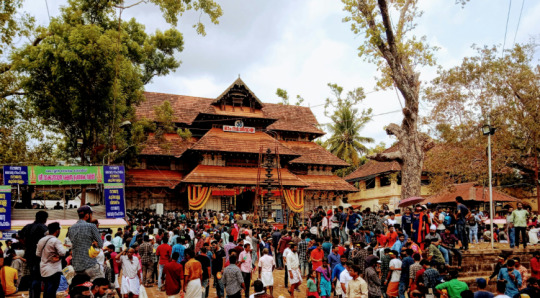
Thrissur, the ‘Cultural Capital of Kerala,’ pulsates with the rhythm of ancient temples, whispering forests, and vibrant festivals. Nestled amidst verdant hills and shimmering backwaters, it’s a land where history paints murals on temple walls, and adventure carves stories into waterfalls. If you seek a Kerala that’s steeped in tradition yet whispers promises of exhilarating escape, Thrissur beckons you.
Where Time Stands Still:
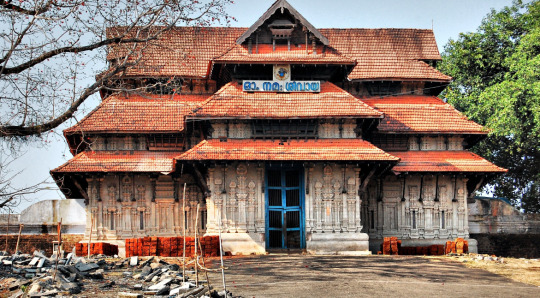
Step into the 1,000-year-old Vadakkunnathan Temple, where a colossal Shiva lingam rests beneath thirteen gold-plated hoods. Marvel at the ancient murals that breathe life into legends, each stroke narrating a forgotten chapter of Thrissur’s past.
Echoes of Royalty:
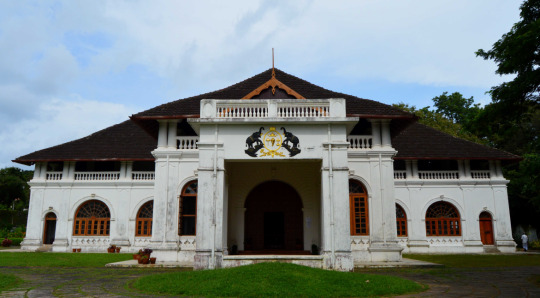
Walk the opulent halls of the Shakthan Thampuran Palace, where whispers of bygone kings linger in the air. Admire the intricately carved teak ceilings, gaze upon majestic portraits, and imagine the grandeur of Thrissur’s royal lineage.
Nature’s Playground:
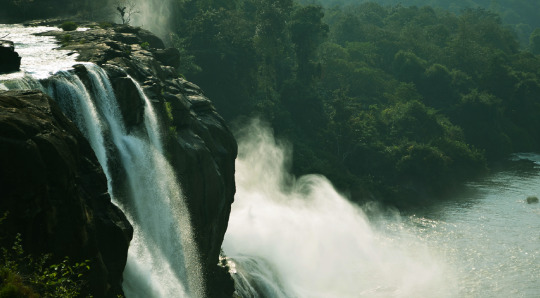
Venture into the emerald embrace of Athirappilly and Vazhachal Waterfalls, where cascading waters serenade the air. Trek through the verdant Periyar National Park, where wild elephants trumpet greetings and ancient trees stand guard. Kayaking through the labyrinthine Chettuva Backwaters, breathe in the scent of mangroves and witness nature’s silent symphony.
A Canvas of Faith:
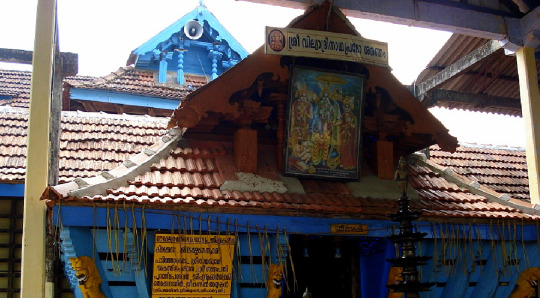
Seek solace in the serene Basilica of Our Lady of Dolours, its stained glass windows casting rainbows of hope. Marvel at the ancient Vilwadrinatha Temple, a testament to Kerala’s syncretic spirit, where Shiva and Vishnu share the sanctum sanctorum.
Festive Spirit:

Immerse yourself in the electrifying Thrissur Pooram, where hundreds of vibrantly-painted elephants parade under a sky ablaze with fireworks. Witness the rhythmic beats of Theyyam, a ritualistic dance form that transports you to the heart of Kerala’s folklore.
When to Book Your Thrissur Trip:
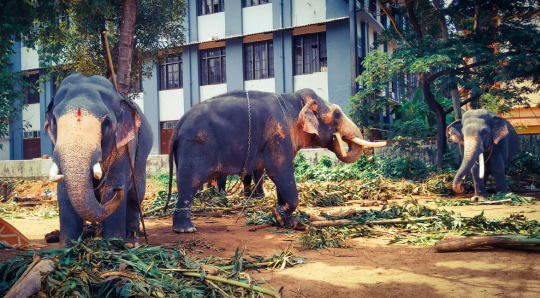
Thrissur welcomes wanderers year-round, each season offering a unique tapestry of experiences:
Monsoon (June-August): Witness the cascading waterfalls at their peak, and experience the verdant countryside come alive.
Winter (November-February): Enjoy pleasant weather, ideal for sightseeing and exploring the outdoors.
Summer (March-May): Dive into the backwaters, indulge in beach bliss, and witness the vibrant Thrissur Pooram in April-May.
Why choose Yashvi Tours & Travels to be your Thrissur Travel Companion?
Thrissur is a tapestry waiting to be unfurled, a melody waiting to be heard. Let Yashvi Tours & Travels be your guide, your confidant, your travel companion as you embark on this journey of discovery. Together, let’s paint your Thrissur adventure with vibrant hues of culture, history, and nature’s breathtaking beauty. We understand that every journey is a unique canvas waiting to be painted, and we specialize in crafting your travel story:
Local Expertise: Our Thrissur-born guides navigate the hidden gems and intricate cultural nuances, ensuring an authentic experience.
Tailor-made Itineraries: We understand your desires, creating personalized itineraries that match your interests and pace.
Beyond the Tourist Trail: Venture beyond the usual sights, experiencing the soul of Thrissur – from attending local festivals to savouring home-cooked delicacies.
Hassle-free Travel: Sit back, relax, and let us handle the logistics, from transfers to accommodation, ensuring a seamless experience.
Embrace the spirit of Thrissur. Pack your bags, choose Yashvi Tours and Travels, and get ready to paint your own Thrissur story.
Article Source : https://www.yashvitours.com/thrissur-where-keralas-heart-beats-with-rhythm-and-revelation/
0 notes
Text
Thrissur Town Homestays Your Home Away from Home in God's Own Country
Experience the charm of Thrissur Town Homestays, your ideal retreat in God's Own Country. Explore 25 engaging topics in this guide.
Thrissur Town Homestays Your Home Away from Home in God's Own Country
Are you seeking an enchanting escape in the heart of God's Own Country, Kerala? Look no further than Thrissur Town Homestays, your home away from home. In this comprehensive guide, we will explore every aspect of these homestays, helping you plan an unforgettable Kerala getaway. From the rich cultural heritage of Thrissur to the warm hospitality of the locals, get ready for a journey that will leave you with cherished memories.
About Thrissur Town Homestays
In the vibrant state of Kerala, Thrissur stands out as a cultural treasure trove. Known as the 'Cultural Capital of Kerala,' this charming town is a haven for art, culture, and tradition. Homestay in Thrissur perfectly encapsulates the essence of this town, offering visitors a unique opportunity to immerse themselves in the local culture.
Why Choose Thrissur Town Homestays?
Thrissur Town Homestays offer an experience that's unparalleled. Here's why you should make them your home away from home:
Cultural Immersion: Immerse yourself in the rich cultural heritage of Kerala. From traditional dance performances to culinary experiences, these homestays offer an authentic taste of Kerala's traditions.
Local Hospitality: Experience the warmth and friendliness of the locals. The hosts at Thrissur Town Homestays are known for their hospitality and are eager to make your stay memorable.
Comfort and Convenience: Enjoy the comforts of home in a new setting. These homestays provide cozy rooms, modern amenities, and delicious home-cooked meals.
Central Location: Homestays near Thrissur in Kerala are strategically located, making it easy to explore the town's attractions, including the famous Vadakkunnathan Temple, Thrissur Zoo, and the cultural center, Koothambalam.
What to Expect
When you choose Thrissur Town Homestays, you can expect:
Traditional Kerala Architecture: Experience the charm of traditional Kerala architecture in every nook and corner of these homestays. The wooden carvings and tiled roofs exude a rustic charm.
Culinary Delights: Savor traditional Kerala cuisine, including mouth watering delicacies like 'sadya' and 'appam with stew.' You can even participate in cooking classes to learn these recipes.
Cultural Performances: Enjoy captivating traditional dance and music performances, like Kathakali and Mohiniyattam, right at your homestay.
Guided Tours: Thrissur Town Homestays can arrange guided tours to nearby attractions, ensuring you don't miss out on the beauty of Thrissur.
Booking Your Stay
Booking your stay at Thrissur Town Homestays is simple. Visit their official website or contact them directly to inquire about availability, pricing, and any special offers.
Exploring Thrissur
A visit to Thrissur is incomplete without exploring the local attractions:
Vadakkunnathan Temple: Visit this ancient temple, a classic example of Kerala architectural style.
Thrissur Zoo: Enjoy a day amidst nature at Thrissur Zoo, home to a variety of wildlife.
Koothambalam: Immerse yourself in Kerala's cultural heritage through dance and art performances.
Sakthan Thampuran Palace: Step back in time at this regal palace that showcases Kerala's history.
Athirapally Waterfalls: Witness the breathtaking Athirapally Waterfalls, often referred to as the 'Niagara Falls of India.'
FAQs
Q: What is the best time to visit Thrissur Town Homestays? A: The best time to visit Thrissur Town Homestays is during the winter season, from October to March, when the weather is pleasant.
Q: Are Thrissur Town Homestays suitable for families? A: Absolutely! Thrissur Town Homestays welcome families with open arms, offering comfortable accommodations and family-friendly activities.
Q: Can I book a Thrissur Town Homestay for a single night? A: While most homestays have a minimum stay requirement of two nights, it's best to check with the individual property for specific details.
Q: Is Thrissur Town safe for tourists? A: Yes, Thrissur is a safe and welcoming destination for tourists. The locals are friendly, and the town is known for its safety.
Q: How can I reach Thrissur Town Homestays from the nearest airport or railway station? A: Thrissur Town Homestays can arrange transportation for you from Cochin International Airport or Thrissur Railway Station upon request.
Q: Are pets allowed at Thrissur Town Homestays? A: Most homestays do not allow pets, but it's always best to check with the specific property for their pet policy.
Thrissur Town Homestays offer an unforgettable experience, allowing you to soak in the beauty, culture, and traditions of Kerala. Your stay here will be more than just a vacation; it will be a journey into the heart of God's Own Country. So, plan your visit, book your stay, and get ready to create cherished memories at Thrissur Town Homestays.
0 notes
Text
Digital Built World Summit: Thinking about Digital Twins for Smart Built Environment
Digital Built World Summit, held in Sydney on 23-24 May by FuturePlace, is the world's premier event for executives in the AEC, Smart City focused on improving digital business outcomes. It was themed on leveraging digital construction technology, including digital twins, to create a smart, responsive, sustainable and autonomous built world, which attracted over 300 attendees and presentations from over 75 leading global speakers. Various seminars took place during the summit, shedding light on developing digital twins.
Digital Twin beyond Technology
The smart building digital twin is a kind of technology, but it goes beyond that for many attending the summit.
Simon Evans, Digital Twin Leader of Arup and Chair of the Gemini Call at the National Digital Twin Programme, argued the digital twin is a methodology, not a technology. "It's an approach of using data to get and derive better insights. It should be lots of different platforms that talk and deliver the insights that you need. … And if there is a tech piece, it is about a constellation of technologies connected; it is never gonna be one giant digital twin platform."
He also noted digital twin transformation is a social-technical challenge that is a much wider, large-scale issue. "It is a journey, not a destination." Technology and use cases are maturing all the time, so what a digital twin looks like today will be very different from a digital twin in the future. "So we should appreciate the journey that provides value, not focus on that unicorn, that end of the journey. It's more about how can I get return investment now, the incremental approach," he added.
It takes years to develop a qualified digital twin or digital twin system, and there's a journey to get people from today to there, said David McKee, CEO of Slingshot and Co-Chair of Digital Twin Consortium. "If you think about the maturity of digital twins, you start with models of simulation to say this is what we gonna build. It's not a digital twin. … as you then build that layer of data, and you start having those real-time data that respond to what you required, it started to graduate to become a digital twin."
"The idea of digital twins as a journey is important because these systems are not static. They are dynamic," elaborated Brett Dixon, Infrastructure Group Lead of Asia Pacific at Esri, "If you're implementing a citywide digital twin or a statewide digital twin, you'll never get to the end because the requirements from the users will just continue to emerge and evolve over time."
Digital twin systems need to evolve with new requirements coming along. Therefore, the frameworks and standards related need to be agile. Brett explained, "They need to encourage and continue innovation and continuous engagement with users … Otherwise, they'll just become static and deliver no value."
Digital Twin Needs to be Purpose-driven
Speakers repeatedly mentioned that digital twin should be purpose-driven, in other words, case-driven. "Everyone is trying to just search for some meaning or for what the digital twin can do and how we can actually articulate its benefits," said Raj Thampuran, Managing Director of Surbana Jurong.
Paul Mullett, Group Director of Engineering and Technology at Robert Bird Group, also emphasised the point around purpose, "It sounds like a bit of a cliche. But actually, this all has to be purpose-driven, and the purpose isn't 'I want x/y/z sensors in my buildings so I can monitor these things. The purpose is 'are all of my buildings more energy efficient or all of my traffic flow more freely?' or whatever it might be. That's the purpose."
The purpose is crucial because it determines what you need from the digital twin and the functionality. This is one key lesson from the National Digital Twin Programme for the United Kingdom. "It determines things like the data refresh rate because not all digital twins need to be with a kind of a real-time data refresh rate. It depends on the purpose," said Mark Enzer OBE, the Global CTO of Mott MacDonald and Head of the National Digital Twin Programme.
There is also a much broader-sensed purpose or vision. According to Mark, the built environment needs to have an explicit purpose which enables people and nature to flourish together for generations. "We reckon that connected digital twins can massively help in that, but it's kind of starting with that endpoint in mind."
Data Becomes More Valuable with People
"The industry captures a lot of data or static data. 96% of that data goes unused." For Bill Harris, Business Development Director for APAC at Asite, data is the new oil. "How do we start taking that static data and combining that with operational data to then start providing value to asset whole of life? That's the question that sits, I guess, in front of us now."
However, Nicolas Waern, CEO and Digital Twin Evangelist of WINNIIO, argued there is a huge difference between data and oil. He thought data could be turned into value and create a lot of impact through different means, like digital twinning, forever and over and over again, unlike oil that was dug out and used once.
And data itself do not provide much value. "The data needs to be turned into information, that information is then transferred into insights, that insight needs turning to action. And that action that we need to take has to lead to an impact. I think that's also a digital twin come in," Nicolas added.
Glodon Vice President Pierpaolo Franco echoed this view in his speech on the topic of Data in Digital Building Platform, saying accurate and real-time data play a crucial role in the building life cycle.
On the other hand, Paul Mullett placed importance on people. "People have always been more valuable than oil. People will remain more valuable than data. And actually, at the heart of all of this are people and their skills and no matter what you wanna do with your digital twins and what your aspirations are." He warned that one of the biggest challenges in the industry right now is developing people's skills.
Just as David McKee said, "data needs managed and do not collect data just for the sake of it, we need to harness that, and there is the value."
Step by Step, Little by Little
But before cashing in the potential and opportunities, here are the challenges to creating and enabling digital twins.
"We are to move towards that type of future of multiple connected digital twins, then we're gonna need to have some form of framework, consistency of approach to allow that connection actually to take place," said Rory Brown, Director of Smart Places Programs at NSW Department of Planning and Environment.
Mark Enzer also mentioned that solving system-level problems and challenges relied on connecting single digital twins. And that connection is all about data sharing. "It's about the digital twin speaking the same language, it's about securely resilient information flow across organisational and sector boundaries." Equally important for him is the standards and guidance generated bottom-up by people learning by doing and then progressing by sharing.
Brett agreed that the main challenges confronting digital twin projects are people and organisational ones. He noted that the path to success must address the people issues, the organisational challenges, the technology and data integration. The focus on the technology will likely lead to failure. Organisations need to think about being dynamic to engage users, and a coalition of the willing should be formed to bring people in and motivate them to work towards a common vision which also needs strong leadership.
None of these can be done overnight. " I t's, not just digital twins, but all big IT projects are risky," Damien Cutcliffe, Director of Business Development and Growth, Digital at WSP , made another point, " If you try to make it perfect upfront, and you hold back on, a sort of exposing that, sometimes you lose advocacy and support. So it's trying not to overdo it at the beginning of things important."
This is agreed by CEO and Founder of BE-WISE Cristina Savian, who said implementation of digital twins at an early stage could easily fail because of trying to do too much, trying to tackle too many cases and trying everything too much at the same time.
A suggestion can be taken from Paul, "Don't be overwhelmed. Take a step at a time. Don't try digital twins on the whole planet. You don't need to. Focus on clear objectives where you want to get to, look at your people and collaborators, and take step by step."

0 notes
Text
"My Favorite Top 10 Movies: A Cinematic Journey Through the Best"
Explore a diverse selection of my favorite top 10 movies, spanning multiple languages and genres, including Thilakkam, Aaram Thampuran, Khakkee, Anniyan, Superman, Race (Part 1), Dhoom, KGF, Malikkappuram, and The Man from U.N.C.L.E.
Daily writing promptWhat are your top ten favorite movies?View all responses
Explore a diverse selection of my favorite top 10 movies, spanning multiple languages and genres, including Thilakkam, Aaram Thampuran, Khakkee, Anniyan, Superman, Race (Part 1), Dhoom, KGF, Malikkappuram, and The Man from U.N.C.L.E.
Introduction:Thilakkam (Malayalam Movie)Aaram Thampuran (Malayalam Movie):Khakkee…

View On WordPress
0 notes
Text
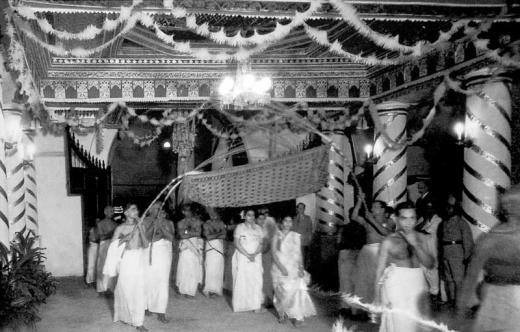
A Royal Wedding - 1934, HH Princess Karthika Tirunal Lakshmi Bayi as a bride under a canopy of red silk held in position by sugarcane in four corners.

Seeking Divine Blessings – 1934. The Royal Bride H H Princess Karthika Tirunal Lakshmi Bayi Visiting Sreekanteswarm Temple.

The Pallikettu of Aswathi Tirunal Gowri Lakshmi Bayi, the Junior Princess of Travancore with vishakham Nal Raja Raja Varma of Paliyakkara in West Palace in 1965.

HH Sethu Lakshmi Bayi with Rama Varma Koil Thampuran on their wedding day (1906)

Her Highness Sri Padmanabha Sevini Vanchi Dharma Vardhini Raja Rajeshwari Rani Bharani Thirunal Lakshmi Bayi, Attingal Mootha Thampuran, Companion of the Order of the Crown of India.
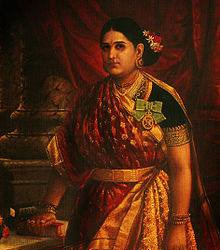
Maharani Bharani Thirunal Lakshmi Bayi CI (1848–1901) was the Senior Rani of Travancore from 1857 till her death in 1901. Her consort was the famous poet and writer, styled the father of Malayalam literature, Sri Kerala Varma Valiya Koil Thampuran.
She died on the 15th of June 1901. As her husband noted in his diary that night,
" My angel, my life, my darling, my all and all, my love, my pride, my idol, my sweetheart- alas! and what not- expired quietly at 8 pm."
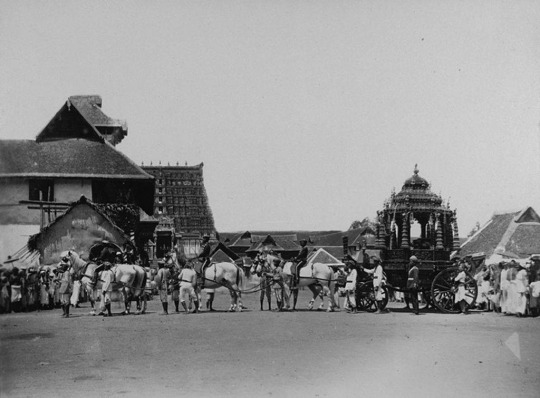
Photograph taken about 1900 by the Government photographer, Zacharias D'Cruz of the Travancore Maharaja's State Carriage in Trivandrum.. It was drawn by a team of six horses. In the background can be seen the gopuram of the Padmanabha Swamy temple.
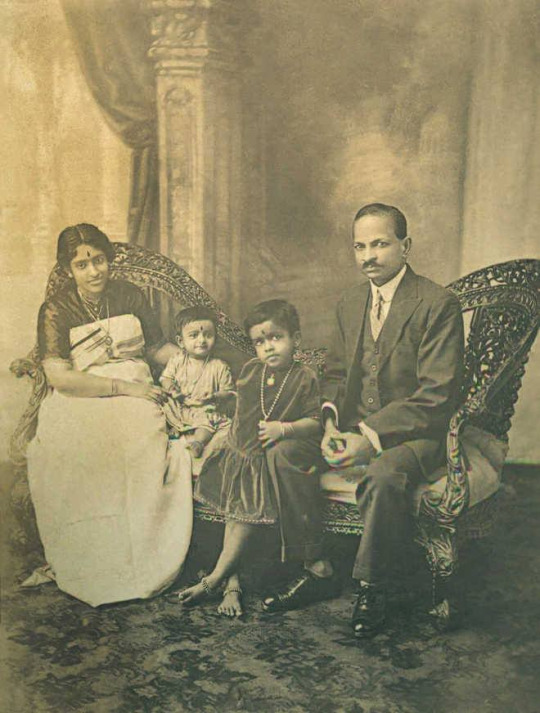
Maharani Sethu Lakshmi Bayi with Her Husband and Princesses Lalitha and Indira.

1928 photograph of Princesses Lalitha and Indira with their mother, the Maharani Regent (Maharani Sethu Lakshmi Bayi).

In Vienna, Austria – 1933. The Travancore Royal Family during their visit to Vienna, Austria. Princess Karthika Tirunal Lakshmi Bayi, Maharani Sethu Parvathi Bayi, Chithira Tirunal Balarama Varma Maharaja and Uthradom Tirunal Marthanda Varma Elayaraja.

Ammachi Panapillai Amma Shrimathi Radhadevi Pandalai - The consort of HH Sree Uthradom Thirunal Marthanda Varma. Very rarely seen. No royal title.
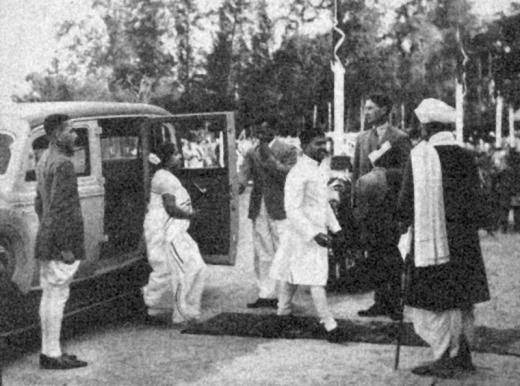
The State of Sports – 1946. H H Chithira Tirunal Balarama Varma Maharaja and H H Maharani Sethu Parvathi Bayi received at the GV Raja Sports School.

Maharani Karthika Tirunal Lakshmi Bayi celebrating her birthday.
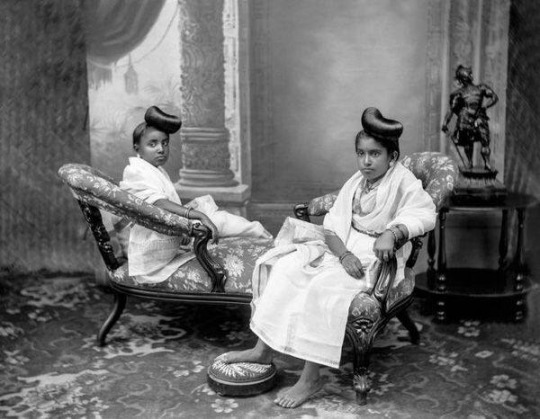
Their Highnesses Maharani Sethu Parvathi Bayi and Maharani Sethu Lakshmi Bayi

The Maharaja and Maharani of Travancore with the Governor of Madras, Lord Erskine, and Lady Erskine at Travancore House, in Adyar, on March 4, 1937, where the Maharaja hosted a party for the Governor. The Dewan of Travancore, Sir C.P. Ramaswamy Aiyer, is seen standing second from left.
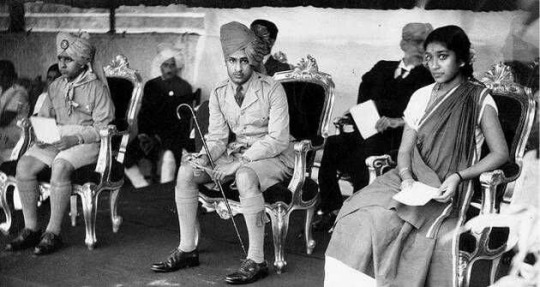
Elaya Raja Marthanda Varma, Travancore Raja Chithira Thirunal and Princess Karthika Tirunal Lakshmi Bayi.

H.H Sree Padmanabha Dasa Chithira Thirunal Bala Rama Varma Maharaja of Travancore, the Last King of Travancore Kingdom and first and only Rajapramukh of Travancore-Cochin State.
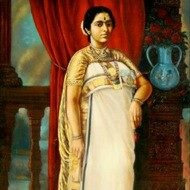
HH Sree Padmanabha Sevini Rajarajaeswari Maharani Sethu Lakshmi Bai Varma, the Queen and Regent of Council- Kingdom of Travancore.
1 note
·
View note
Text
SAKTHAN THAMPURAN NAGAR Branch Office 0782 SAKTHAN THAMPURAN NAGAR, KANNANKULANGARA, TRISSUR 680001
0 notes
Text
youtube
Harimuraleeravam for @chivaraku-migiledi and @jukti-torko-golpo
Harimuraleeravam is a piece of art in the silver screen . It is in the movie aaram thamburan (aaram thamburan is my 20th fav movie )
#Youtube#Harimuraleeravam#hindustani shastriy sangit#desi#mard maratha#teen teen har har mahadev!!!!!#k.j.yesudas#mohanlal#lalettan#aaraam thampuran#malayalam cinema#!!!!!!!!!!!!!!!!!!#the best song#kathak
2 notes
·
View notes
Photo

Vadakkumnathan Temple This is where the Thrissur Pooram takes place every year. Trichur, Kerala #ulsavam #kerala #thrisur #thrissur #aanakambam #thrissurinsta #pooram #keralaelephant #elephants #aanapremi #ramachandran #thechikottukavu #pooramvibes #aanachandam #aanakutty #aanakeralam #ulsavakeralm #aanaprathan #thampuran #pampadyrajan #trissur #poorapremi #kerlalaelephant #aaankutty #elephantslovers #godsowncountry #photography #aana #temple #petersclicks (at Sri Vadakkumnathan Kshethram) https://www.instagram.com/p/BxIG-NVh8j0/?utm_source=ig_tumblr_share&igshid=85fg4mnabc5z
#ulsavam#kerala#thrisur#thrissur#aanakambam#thrissurinsta#pooram#keralaelephant#elephants#aanapremi#ramachandran#thechikottukavu#pooramvibes#aanachandam#aanakutty#aanakeralam#ulsavakeralm#aanaprathan#thampuran#pampadyrajan#trissur#poorapremi#kerlalaelephant#aaankutty#elephantslovers#godsowncountry#photography#aana#temple#petersclicks
0 notes
Text
0 notes
Text

Send from Sansgreet Android App. Sanskrit greetings app from team @livesanskrit .
It's the first Android app for sending @sanskrit greetings. Download app from https://livesanskrit.com/sansgreet
Sree Chithira Thirunal Balarama Varma
Sree Padmanabhadasa Sree Chithira Thirunal Balarama Varma (7 November 1912 – 20 July 1991), popularly known as Sree Chithira Thirunal, was the last ruling Maharaja of the Princely State of Travancore, in southern India until 1949 and later the Titular Maharajah of Travancore until 1991. Sree Chithira Thirunal was the eldest son of Junior Maharani of Travancore, H.H. Sree Padmanabhasevini Vanchidharmavardhini Rajarajeshwari Maharani Moolam Thirunal Sethu Parvathi Bayi, and Sri Pooram Nal Ravi Varma Koyi Thampuran of the Royal House of Kilimanoor. He was privately educated, and became the Maharajah of Travancore, at the age of 12, upon the death of his maternal great uncle, the then Maharajah of Travancore Sree Moolam Thirunal, on 7 August 1924. He reigned under the regency of his maternal aunt, Sethu Lakshmi Bayi (1924–31), until he came of age and was invested with full ruling powers on 6 November 1931.
#sansgreet #sanskritgreetings #greetingsinsanskrit #sanskritquotes #sanskritthoughts #emergingsanskrit #sanskrittrends #trendsinsanskrit #livesanskrit #sanskritlanguage #sanskritlove #sanskritdailyquotes #sanskritdailythoughts #sanskrit #samskrit #resanskrit #sreechithirathirunal #travancore #travancoreroyalfamily #kilimannoor #sreepadmanabhadasa #venad #keralakings #celebratingsanskrit #sreepadmanabhaswamytemple #trivandrum #thiruvananthapuram
#greetingsinsanskrit#sanskritgreetings#sanskrittrends#trendsinsanskrit#livesanskrit#sanskrit#celebratingsanskrit#kerala
0 notes
Text
Royal !!

0 notes
Photo

“Kerala Verma Pazhassi Raja Thampuran is right to be called Kerala Simham (Lion of Kerala). He fought the English East India company till his last breath. The true sense of duty to be found amongst kings. I admire hime for that.” - Submitted by lemmethinkofsomething
11 notes
·
View notes
Text
Kathakali - The Grand Spectacle of Kerala
Kathakali is a profoundly stylised old style move show portrayed by its alluring make-up of its characters, expound outfits, definite motions and very much characterized body developments introduced in line with the grapple playback music and going with percussion. It began in the territory of Kerala during the sixteenth century AD, roughly somewhere in the range of 1555 and 1605. Kathakali has experienced fast updation and enhancements throughout the years.
The fundamental rights of a fruitful Kathakali entertainer are his aptitudes of fixation and physical endurance. Imperative endurance to last an entire night of thorough execution is picked up from controlled preparing dependent on Kalaripayattu, the old military craft of Kerala. This preparation readies an on-screen character for his requesting job. The preparation can frequently keep going for 8-10 years, and is escalated. The serious Kalaripayattu preparing has additionally subliminally impacted the non-verbal communication of Kathakali characters.
Historical underpinnings:
The name Kathakali gets from the Malayalam words "katha" (story) and "kali" (which means: play or execution).
Brief History:
As indicated by legends, Kathakali began from a forerunner move show structure called Ramanattam and owes a considerable lot of its exhibitions to Krishnanattam. To put it plainly, these two forerunning structures to Kathakali managed introducing accounts of the Hindu Gods Rama and Krishna (both are natural appearances of the Preserver among the Hindu trinity-Vishnu).
Legend has it that Kottarakkara Thampuran (1555-1605) (leader of the south Kerala area of Kottarakkara) formed most plays dependent on the Ramayana that in the long run prompted the development of Kathakali. In spite of the fact that Ramanattam as a work of art is wiped out, its accounts keep on living as a piece of Kathakali.
Kathakali is the consequence of effective amalgamation from different artistic expressions. It imparts likenesses to Krishnanattam, Koodiyattam (a Sanskrit dramatization execution of Kerala) and Ashtapadiyattam (an adjustment of twelfth century melodic called Gitagovindam). It likewise joins a few components from other conventional ceremonial works of art like Mudiyettu, Thiyyattu, Theyyam and Padayani other than a minor portion of society expressions like Porattunatakam.
Kathakali melodies are rendered in Manipravalam-which is a blend of the traditional language Sanskrit and neighborhood language Malayalam. Despite the fact that a large portion of the melodies are set in ragas dependent on the microtone-overwhelming Carnatic music, there is an unmistakable style of plain-note interpretation, which is known as the Sopanam style. This normally Kerala style of version takes its underlying foundations from the sanctuary melodies which used to be sung (proceeds even now at a few sanctuaries) when Kathakali was conceived.
The characters of Kathakali show up with vigorously painted faces and expand outfits. The movement is profoundly best in class (principally created Kaplingad Narayanan Namboodiri - 1739-1789) and authorizes stories transcendently from the Hindu sagas. Despite the fact that Kathakali was customarily been acted in sanctuaries and castles,Alex Kime Chicago over the previous century it has likewise discovered settings in post-reap paddy fields just as proscenium phases of open corridors/auditoria. Kathakali is a visual treat and its green painted entertainer has gotten interchangeable with the raised culture of Kerala.
Noticeable highlights of Kathakali:
Kathakali comprises of five old style components of compelling artwork:
Articulations (Natyam, the segment with accentuation on outward appearances)
Move (Nritham, the segment of hit the dance floor with accentuation on mood and development of hands, legs and body)
Establishment (Nrithyam, the component of dramatization with accentuation on "mudras", which are hand signals)
Tune/vocal backup (Geetha)
Instrument backup (Vadyam)
Kathakali plays
Generally there are 101 traditional Kathakali stories. The most usually organized stories among them may associate with 30-40. In those occasions when amusement media was amazingly constrained, Kathakali exhibitions were intended to last an entire night. We may state it might have evoked the reaction of a contemporary live performance.
Execution
Kathakali in its most flawless structure is acted before the immense Kalivilakku (kali importance move or execution and vilakku meaning light). The light was lit with a thick wick fuelled by coconut oil. This light was the single wellspring of brightening when the plays used to be performed inside sanctuaries, royal residences or homes of aristocrats and blue-bloods. This aided in making a feeling of wonderment and riddle and helped the entertainer misrepresent the characters he played. It was conceivably one of the principal compelling employments of light to highlight the characters and make a display.
Kathakali is instituted with the backup of music (geetha) and instruments (vadyam). The percussion instruments utilized are Chenda, Maddhalam and Edakka. The lead artist is classified "Ponnani" and his devotee is designated "Shingidi". The lead artist utilizes the "Changala" (gong made of chime metal, which can be hit with a wooden stick) to direct the Vadyam and Geetha segments, similarly as a conduit utilizes his wand in western traditional music and the Shingidi utilizes the "Elathalam" (a couple of cymbals) to add a variety to the music. Most music is customarily framed in gatherings of up to 14 individuals. Be that as it may, typically the melodies are formed with more than 20 individuals.
The distinctive element of Kathakali is that the entertainers never talk yet use hand signals, articulations and cadenced moving rather than discourse (however for two or three uncommon characters). The story is established simply by the developments of the hands (called mudras or hand motions) and by outward appearances (rasas) and substantial developments. The articulations are gotten from Natya Shastra (the tome that manages the study of articulations) and are arranged into nine as in most Indian old style fine arts. Artists additionally experience exceptional practice meetings to learn control of their eye developments.
Kathakali execution rotates around 24 essential mudras - the change and mix of which would include a piece of the hand motions stylish today. Each can be separated again can be grouped into 'Samaana-mudras'(one mudra representing two substances) or "Misra-mudras" (both the hands are utilized to show these mudras). The mudras are a type of gesture based communication used to recount to the story.
The fundamental outward appearances of a Kathakali craftsman are the 'Navarasams' (Nine tastes or articulations). The Navarasams are: Sringaram (love), Hasyam (scorn, humor), Bhayanakam (dread), Karunam (sentiment), Roudram (outrage, rage), Veeram (valor), Beebhatsam (sicken), Adbhutam (wonder, awe), Shantam (serenity, harmony).
Kathakali has an intricate make-up code. The make-up might be characterized into five essential sets to be specific Pachcha, Kathi, Kari, Thaadi, and Minukku. The contrasts between these sets lie in the prevalent hues that are applied on the face. Pachcha (which means green) has green as the prevailing shading and is utilized to depict honorable male characters that are said to have a blend of "Satvik" (devout) and "Rajasik" (regal) nature. Rajasik characters having a detestable streak ("tamasic"= fiendish) - no different they are screw-ups in the play, (for example, the evil spirit ruler Ravana) - and depicted with dashes of red in a green-painted face. Too much underhandedness characters, for example, evil presences (absolutely tamasic) have an overwhelmingly red make-up and a red facial hair. They are called Chuvanna Thaadi (Red Beard). Tamasic characters, for example, ignoble trackers and woodsmen are spoken to with a transcendently dark make-up base and a dark facial hair and are called Kari/Karutha Thaadi (which means dark whiskers). Ladies and religious zealots have glistening, yellowish appearances and this semi-sensible classification shapes the fifth class. Moreover, there are alterations of the five fundamental sets portrayed better than as Vella Thadi (white whiskers) used to delineate Hanuman (the Monkey-God) and Pazhuppu, which is significantly utilized for Lord Shiva and Balabhadra.
Minukku
Minukku is the cleaned assortment of facial make-up comprising in smoothening the entertainer's face with a covering of a blend of yellow and red shades. The arrangement gets 'a self' (or normal skin) appearance shading. It mirrors the characters normally found in Brahmins, Ascetics and Virtuous ladies. The eyes and eye-lashes are painted and shapes lengthened with the dark unguent and oily collyrium. Some of the time the face is enriched with white or cream shading specks, running from the cheeks to the front head in a bow-shape. The lips are blushed and the temple is enriched with a station mark. This shading plan serves to give a representative sparkle of devotion to a fan character. Ladies job types are given sensitive contacts of the make-up.
Pachcha
Pachcha delineates a dark green face. The endorsed jobs are Gods, commended legendary saints, and ethical personages, representing internal refinement balance, chivalry and good greatness. This incorporate legends of a play and honorable characters, Indra, Krishna, Rama, Lakshmana, Bharata, Sathrugnan, Harishchandra and Nala. The forward portion of their appearances is given smooth dark green base on which chuttis (white rice-glue bends) run from the focal point of the jawline, covering the lower jaw, to either side of the face. The eyes and the eye-lashes are painted dark and the lips splendid red. It expect the state of a wide cutting edge saber or of a broad bend of a bow. The brow, over the tie formed painted segment, is secured by a red lace of the overlaid head gear.
1 note
·
View note
Text
Shakthan Thampuran Palace
Shakthan Thampuran Palace in the City of Thrissur in Kerala State -India also known as Vadakkekara Palace is a two-storeyed building constructed in traditional Kerala Style “Nalukettu”. High roofs, extra thick walls, spacious rooms and floors paved with finely smoothened Italian marbles are some of the structural specialities of this palace. The interiors of the palace, because of its unique construction offer comfortable and pleasant staying conditions irrespective of the prevailing weather conditions.
This was the centre of power of King Rama Varma Sakthan Thampuran, who ruled Kochi between AD 1790 and 1805. His rule was regarded as the Golden Era of the Cochin dynasty. Sakthan Thampuran is credited with the introduction of the Thrissur Pooram festival, an annual festival in May
I wasn’t allowed to take photographs of the interiors of this palace as it was converted to a museum by the State Government in the year 2005 and the Security team over there had warned me not to take any shots inside palace. Hence we get to see only the exteriors.
One thing that I felt bad after my visit was that, I couldnt get to see any handbook in regards to the history of this and I had to depend a lot on Wiki. Also I dont think there are any remains of items used by Late His Highness Shakthan Thampuran.










1 note
·
View note